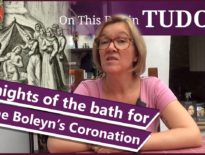On this day in Tudor history, 29th May 1593, Welsh religious controversialist, and a man regarded by Welsh historians as the pioneer of Welsh nonconformity, John Penry was hanged at St Thomas-a-Watering in Surrey.
John Penry was linked to the Martin Marprelate tracts and the resulting Marprelate Controversy, not for writing them, but for helping to run the secret press that printed them.
Find out more about Penry, his life and his work, and his involvement with these tracts, and how appealing to William Cecil didn't save him from the hangman's noose, in today's talk.
Here's Claire's talk on Job Throckmorton, a colourful and lucky character:
You can read more about the Martin Marprelate Press and Controversy at http://people.umass.edu/marprelate/index.html
Also on this day in Tudor history, 29 May 1533, the celebrations for Queen Anne Boleyn’s coronation kicked off with a spectacular river pageant on the Thames. Find out more in last year’s video:
Also on this day in history:
- 1500 – Death of Thomas Rotherham, Archbishop of York, at Cawood Castle, Yorkshire. He was buried in York Minster.
- 1542 – Death of Sir Thomas Neville, lawyer and Speaker of the House of Commons, county commissioner in Kent, Surrey, Sussex, and Middlesex, and Knight of St John. He was the fifth son of George Neville, 2nd Baron Bergavenny. Neville was buried in Mereworth church in Kent.
- 1546 – Murder of David Beaton, Cardinal and Archbishop of St Andrews, at the castle in St Andrews. He was killed by a small group of Fife lairds. One motive was their outrage at the recent trial and execution of Protestant preacher George Wishart at St Andrews.
- 1555 – Birth of George Carew, Earl of Totnes, soldier, administrator and Lord President of Munster. He was a member of James I's Privy Council and his council of war. He was also a friend of Sir Walter Ralegh, and pleaded unsuccessfully for his life.
- 1623 – Burial of Francis Anthony, alchemist and physician, in the church of St Bartholomew-the-Great.
Transcript:
On this day in Tudor history, 29th May 1593, Welsh religious controversialist, and a man regarded by Welsh historians as the pioneer of Welsh nonconformity, John Penry was hanged at St Thomas-a-Watering in Surrey.
Penry had been found guilty of “publishing scandalous writings against the church” after having been linked to the “Martin Marprelate tracts.” These religious tracts, which attacked the established church, were written under the pseudonym Martin Marprelate (and his sons) and published in 1588 and 1589 by John Penry and Robert Waldegrave.
The publication of these tracts resulted in the Marprelate Controversy, a pamphlet war between the tract writers and defenders of the Church, including Thomas Cooper, Bishop of Winchester; writer and playwright John Lyly, writer and playwright Thomas Nashe, and dramatist Robert Greene.
I talked about the pamphlet war in my talk on Job Throckmorton on 23rd February, so I’ll give you a link to that.
But let’s get back to John Penry…
Penry was a Welshman who hailed from Brecknockshire, and who’d been educated at the Universities of Oxford and Cambridge, graduating BA and MA. He would not be ordained as a priest because he was of the view that the present church was insufficiently reformed. Instead, he became a licensed University Preacher.
In 1587, he published a treatise on the state of the church in Wales, which, after he and Job Throckmorton, MP for Warwickshire, had pushed for it to be discussed in Parliament, saw Penry being accused of publishing treason and heresy. Penry was found guilty and imprisoned for a month in the Gatehouse Prison.
This trouble didn’t put Penry off, and he published a longer work through printer Robert Waldegrave, which, as his biographer Claire Cross points out, “denounced the bishops as soul murderers for their neglect of the people of Wales”. Waldegrave’s home was raided in April 1588, but Waldegrave went on to publish another tract by Penry in August 1588.
Although Penry’s supporter Job Throckmorton is thought to have been Martin Marprelate of the Marprelate Tracts, historian Claire Cross states that the majority of historians believe that Penry played a minor part, if any, in the actual writing of the tracts, although he is associated with the secret press. The press was moved from place to place, including London, Fawsley and Coventry to escape detection and while it was printing the Marprelate tracts, it was also being used to publish works by Penry.
In 1589, Waldegrave left England for France for a few months due to his worries over the Marprelate tracts, and Penry worked with a new printer, John Hodgkins. The press was apprehended on a move to Manchester in August 1589 and Penry went into hiding before fleeing to Scotland with his wife, Helen or Eleanor Godley, supported financially by Job Throckmorton, in October 1589. Waldegrave also fled there. Penry published further religious work in Scotland, defending Scottish presbyterians and also a translation of a work by Theodore Beza, but after complaints from the English government, King James VI proclaimed Penry an outlaw in 1590. In late 1592, Penry travelled to London, where he became involved in a separatist church led by Francis Johnson, Henry Barrow and John Greenwood, preaching there and also petitioning for the release of members who’d been imprisoned. He also published a tract defending the separatists.
On 22nd March 1593, Penry was arrested at Stepney, after the vicar of Stepney told authorities of his whereabouts, and interrogated. He confessed to publishing two works during his time in Scotland, and then during his imprisonment wrote a work in which he made clear his loyalty to Queen Elizabeth despite his views on the church.
Separatist leaders Henry Barrow and John Greenwood were hanged for treason at Tyburn on 6th April 1593. Penry wrote farewell letters to his wife, and daughters, Deliverance, Comfort, Safety, and Sure Hope, the eldest being only 4, and he also wrote one to the separatist congregation over the next few days, and then, on 21st May he was tried, accused of sedition, of trying to overthrow religion and incite rebellion. The trial was suspended after Penry appealed to William Cecil, Lord Burghley, against the court using information from private papers he’d had in Scotland. He also defended himself well, pointing out that far from encouraging rebellion, his teaching was “the clean contrary”. But when his trial opened again on 25th May, he was found guilty of publishing scandalous writings against the Church. Penry appealed once more to Burghley, but it was no good. Archbishop Whitgift hastened to draw up and sign his death warrant, which was also signed by Sir John Puckering, Keeper of the Great Seal, and Chief Justice Sir John Popham, who had sat in judgement on Penry.
On this day in 1593, thirty-year-old John Penry was just finishing his lunch when he was taken, fixed to a hurdle and dragged to St Thomas-a-Watering in Surrey. There, he was prevented from making a speech before he was hanged. Penry’s work wasn’t over, though, as following his death a seditious pamphlet was published, stating that it was written by Mr John Penry, a Martyr of Jesus Christ.



Leave a Reply